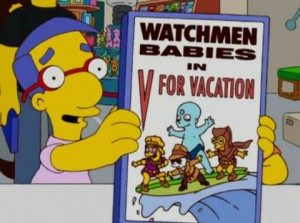 In preparation for the March release of its film adaptation, I reread Watchmen this week. It had been more than four years. Back then, I liked it, but it wasn’t the time for me to read it. I hadn’t been exposed to as many “real” superhero comics yet, and the world, while sucky, didn’t seem apocalyptic to me at the time. This time around, Watchmen hit me a lot harder. I mean, “Who watches the watchmen?” could be talking about I-bankers, right? And Dr. Manhattan is the market’s invisible hand? No?
In preparation for the March release of its film adaptation, I reread Watchmen this week. It had been more than four years. Back then, I liked it, but it wasn’t the time for me to read it. I hadn’t been exposed to as many “real” superhero comics yet, and the world, while sucky, didn’t seem apocalyptic to me at the time. This time around, Watchmen hit me a lot harder. I mean, “Who watches the watchmen?” could be talking about I-bankers, right? And Dr. Manhattan is the market’s invisible hand? No?
For years, Alan Moore (the writer of Watchmen) has been saying that his comics are unfilmable. He has a beef with Hollywood that is easy to understand, especially if you’ve seen the god-awful adaptations of his League of Extraordinary Gentlemen and From Hell. In the late 80s, Terry Gilliam approached Moore, thinking he’d direct the Watchmen film. Instead, Moore told Gilliam that it was an impossible task, like finding the Holy Grail or filming Don Quixote. Terry Gilliam agreed. Watchmen was unfilmable.
But is it really?
Comics and Film: A Comparison
“If you approach comics as a poor relation to film, you are left with a movie that does not move, has no soundtrack and lacks the benefit of having a recognizable movie star in the lead role.”
-Alan Moore
Comics and movies aren’t the same. It’s easy enough to say, but I sometimes get the feeling that most comics writers don’t get it. People working in the film industry definitely don’t; they often explicitly say they use comics as storyboards for their films.
But they aren’t the same. Because Alan Moore is one of the few comics artists who realizes that, his comics will necessarily be harder to translate to film. Here’s a breakdown of what each medium can and can’t do well. I think it’ll give everyone an idea of why Watchmen is a tough piece to tackle.
Time in film.
Time in film is tricky, which is why, I expect, most films occur in order. The beginning’s at the beginning, the middle’s in the middle, the end’s at the end. Obviously, not all films work this way. Some of the best movies of all time don’t: Citizen Kane, It’s a Wonderful Life, Casablanca, Pulp Fiction.
But it’s a lot harder to pull off. Usually, you have to do it in flashback: a character says something about the past, he puts on that faraway drugged out look, and – cue harps and smoke machines – we’re back in the past with them. It’s weird, actually. Most of the film we were watching the characters objectively; now, we’re in someone’s head, thinking along with them, but still watching them from afar.
Tarantino doesn’t use flashback as much – in fact, god help you if you say he uses flashback in his films at all. Rather, he uses chapter headings to separate one period of time from another so viewers know where they are. Woody Allen movies use a narrator, making them more like novels. Some movies have dates written at the bottom of the screen. Harry Potter movies use a nifty contraption called a Pensieve, which is made out of flashbacks. These are obvious ways of letting a viewer know when they are. Unless a director is very explicit, a viewer can easily get lost in the timeline. And if a viewer gets confused about where she is in the timeline, she can’t go back and reread the movie. The movie goes on, whether the viewer gets it or not.
Long gaps in time must be avoided in films, too. Otherwise, you need to put your thirty-year-old hot starlet in plastic wrinkles and a grey wig. It doesn’t usually work too well.
Time in comics.
Comics can handle time better than movies but less well than novels. Artists can draw characters whatever age they want and can put any props they want in the background of scene. It’ll take some research, sure, but it’s cheap and not too hard.
Although comics can jump around in time, because of their visual nature they work more like movies. Unlike a novelist, a comics author can’t jump back and forth between centuries within the same sentence. A novelist could just write, “During World War II, he was a soldier, but now he was just a dentist.” A comics artist would have to draw two panels: one with a soldier, and one with a dentist.
But comics authors can jump around more frequently than a film director. Even the most artsy indie film can only jump around the timeline maybe forty times. If the movie jumped more than once every few minutes, the audience would go CRAZY. And the director would, too.
But, theoretically, a comics author could jump to a new time period every panel. In fact, the Dr. Manhattan chapter of Watchmen (for the most part) does just that. And that is cool. Plus, if a reader gets confused, he can always flip back a few pages and reread. As in a novel, time moves only as quickly as the reader does.
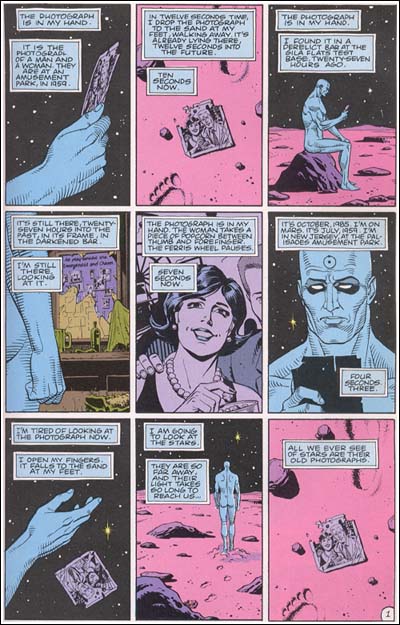
Dr. Manhattan makes time... complicated.
The senses in movies.
Movies win this round due to the realism of their visuals and their use of music. Why do people always clamor for film adaptations of their favorite novels or comics? I think it’s because they want to see their favorite characters and scenes come to life. Comics wouldn’t do it. People want the realism. They want to see the movement.
And music. Because of music (or lack thereof, as in No Country for Old Men), a movie can make an audience feel anything. This can be seen either as a very good thing or a very bad thing. Alan Moore would probably say that music was another way for directors to spoon-feed their audiences and force them to feel whatever they want them to feel at the time. As for me, I think music is amazing – the number one reason movies are better than any other art form.
The senses in comics.
Comics win due to detail. Comics don’t have music, and you can’t smell or taste or feel them.
In terms of visuals, though, comics get the best of the novel and film worlds. Like movies, comics can tell
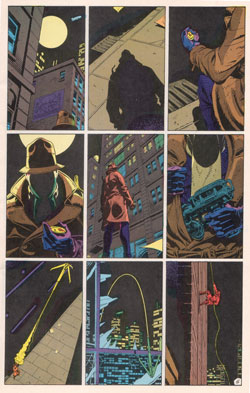
Page five of Watchmen
a story MUCH more quickly than a novel by using visuals. One panel, like one second of film, can get across a huge amount of information to a reader. Imagine reading that amount of information in a novel:
“Underneath a large full moon in Manhattan stood a turn of the century skyscraper. A man at its base looked up at it. He wore a hat that looked kind of like a fedora and was brown, but not too dark brown, just regular hat brown. The hat had a thick purple ribbon around its rim – but not a garish purple. A dull purple. He wore an old-fashioned trench coat, same brown color as the hat, draped in shadow. Striped pants – zoot-suit-ish – and purple gloves to match the hat ribbon. In his hand, he clasped something, and, around him green papers swirled in the wind.”
That is my description of one panel of Watchmen. One very uneventful panel. (It’s the middle one on page 5 if anyone cares.) On almost every page of Watchmen, there are nine panels. There are about 385 pages in Watchmen, meaning that you would have to multiply that boring paragraph times 3465 to get close to what a novelization of Watchmen would look like. If you double space that paragraph and put it into Courier New, that paragraph is almost half a page of novel text. At this rate, that means the novelization of Watchmen would be at least 1700 pages long to get in that amount of information. That’s the number one difference between a comic and a novel.
A movie could have that same amount of detail, but a viewer couldn’t appreciate it as well. Movies, as said before, move. A viewer can’t linger on a frame and appreciate every detail in it, unless he is watching it on
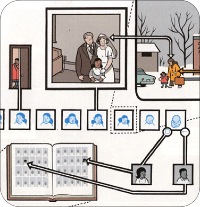
Jimmy Corrigan: Unfilmable
DVD. (Who else but Roger Ebert actually does this, though?) That’s why comics can include maps (see Hicksville and Fun Home), mechanical diagrams (see Jimmy Corrigan), and intricate cityscapes (see anything by Joe Sacco), and movies can’t.
Even if you did want to write a 1700 page novelization of Watchmen, you STILL couldn’t get across all the information. Novels can’t deal with issues of space and composition. Movies can, sort of, but today scenes are cut so fast that viewers don’t have that much time to pay attention to that stuff. Anyway, in a novel or a film, the cleverness of Chapter Five, Fearful Symmetry, for example, would be lost. Chapter Five – and you might not have noticed even if you read the comic – is completely symmetrical. All twenty-nine pages of it. You couldn’t do that in a novel. You couldn’t even do that in a movie. That’s something only a comic can do.
Scope in comics.
Comics, theoretically, can be as long as an author wants. You can write series. You can spend your whole life developing backstories. You can have spinoffs. You can wring every last drop of juice from your premise if you want.
Scope in movies.
If you are a film director, you have between 90 minutes and 120 minutes to tell your story. If you are particularly lucky, you may have up to 160 minutes. If you are super lucky, you are Peter Jackson and you got to do three three-hour long movies.
In other words, you can have good character development but few characters, or many characters but little to no character development. Your choice. Don’t expect your themes to be particularly deep. You don’t have time to develop them.
So is Watchmen filmable or what?!
My answer is “yes, but…” Is Watchmen filmable? Yes, but it’s going to lose a lot. I don’t care how careful the director, Zack Snyder, claims he is trying to be. Any transition to film is going to be rough. As I showed above, just because comics are visual, it does not mean that they are easier to adapt to film than novels.
So what’s Watchmen going to lose?
Its visual detail: I’m sure we’ll see smiley faces in the background of certain scenes, but that’s about it. We simply won’t be given the time to analyze the contents or compositions of each frame. Movies don’t allow that.
Some character development: Dr. Manhattan will keep his since his backstory is vital to the events in the story-story. I expect Rorschach will get some development since everyone seems to like him so much. Unfortunately, the Sally-Laurie subplot might get condensed or even axed, which is sad because it was easily the most human story in the book. Nite Owl the First will, I predict, get no history. The psychiatrist and his wife will be cut. The Laurie-Dan subplot will get play (can’t have a movie without a love story!), but I expect it will be less complex than the original due to time constraints.
The “books within books.” While I can’t fault the filmmakers for getting rid of the pirate comic book, the academic texts on superhero politics and bird watching, or Ozymandias’ internal memos about his product line, I’ll be sad to see them go. They’re what gave the comic texture. The film is going to be sleek and easy like all Hollywood products, not bursting at the seams like the comic. Films just can’t have that amount of layering.
The intertextuality. I’ll eat my hat if the movie uses the quotations the comic used. Except for “who watches the watchmen.” Someone will say that, or at least it’ll be somewhere in the background. Otherwise people will leave the movie saying, “But why was it called ‘Watchmen’? Weren’t they called the Minutemen?”
That’s not all the movie will lose, probably, but those are the things that the film will necessarily lack, due to its form. Due to Hollywood meddling, we also might see less moral ambiguity, although if they make Rorschach into a hero I might start laughing in the theater.
But the trailer doesn’t suggest that. I do think Mr. Snyder wants to make a relatively faithful film. As long as he keeps that dark, foreboding mood, then he’ll get as close as he can.
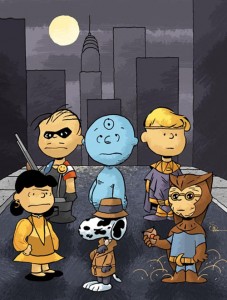
A slightly less dark version of Watchmen
***
As a gift for reading through this long, unfunny article, you get to watch the Watchmen trailer! Enjoy.
http://www.youtube.com/watch?v=E4blSrZvPhU
Oh my God. It’s symmetrical. Oh my God. Oh my God. Oh my God.
(thought I’d transcribe roughly my response to digging out my copy of Watchmen and giving it a look. Except I may have gone with “Jesus Christ.”)
Another point- realism. In a comic everything is in the same style, its real, solid, tangible. Nothing about it differs from its world. Whearas when you switch to film there is a clear difference between CGI and humans. Note how insubstantial Dr. Manhattan looks compared to the other humans. You don’t get that feeling that he is part of the world, he looks like a hologram.
I’d really rather they’d just painted someone blue or used a human with makeup, Silent Hill proved that could be done very effectively
On the Laurie-Dan front you can’t help but notice the costumes. Everyone looks more, dare I say it, badass. Laurie in particular has gone from having a deliberately very silly outfit to some kind of leather jump suit and I can’t help but feel that will translate into making her more of a Hollywood ‘strong’ female character rather than a strong individual in her own right.
You’re right, ch5 IS symmetrical. Holy sh*t. My mind, ’tis boggled.
Leave it to me to tie in Batman, but I think the costume change is the product of our modern era and how ever since the first string of Batman movies, superhero (and thus comic-based superhero) movies haven’t had what looks like Spandex (with the exception of _Superman Returns_, but look at how that one totally bombed), even if that’s what the original concept looks like. Burton’s Batman was kind of plastic and buff, his costume made of rubber instead of cloth; and, for whatever reason, others like Daredevil followed suit (hah!). While the X-Men and Fantastic Four costumes (for example) aren’t necessarily plastic/rubber, they do look fairly different from the original pictures they were derived from, and closer to the Burton interpretation of Batman’s outfit than their original forms. Yeah, Silk Spectere II’s outfit looks somewhat ridiculous even in the comic; and yes, that’s most definitely on purpose and serving a point; but that outfit would just be OUTLANDISHLY ridiculous if it was flapping around in a movie, probably to the point of distraction. That’s why you never saw Wolverine’s film version in anything remotely resembling his comic outfit (seeing ANY real-life man running around in THAT would be disturbing at worst, to comedic somewhere in the middle, to arousing at best, depending on your tastes and sense of humor). So between trends (plastic) and translation (how seriously it can be taken in a moving medium), the outfits are changed. (By the way, when first I saw the preview, I couldn’t help but note how Nite Owl II didn’t look remotely pudgy as he did in the graphic novel, which is important to his character; and that while Ozy was supposed to have the perfect physical physique, his pecks and pack were ultra-defined in that preview, emphasized more with the padding of the costume there than the Spandex or whatever of the original could do.)
It would have been kind of nice to see what you think it can GAIN in film version, since you said you believe film is the best form of art. I think a lot of the stuff you said is good about films can help to make up for some of what lacks. You’re probably right in that Moore would think a soundtrack is just another way for directors to spoon-feed, but I personally think a soundtrack will make it even more awesome. When I read things, I try to find music that would sort of match what I’m reading to help me get into the mood; and so I *like* how music in movies does that. Also, some elements will just be more awesome when seen in real-time (or slow-mo, even), like fight sequences and flames (the bit in the trailer of R. with the can is so snazzy!).
I have a group of friends that is nerdy enough to have read _Watchmen_ for the most part, even if not all of us/them were born yet when it was first published, and we have decided to form a “_Watchmen_ Book Club” that will totally pwn Oprah. We’re all re-reading it and will go see it together in order to discuss both versions, compare-contrast, etc.
The graphic novel came out the year I was born (so do the math if you care), and the movie comes out on my birthday (theoretically- if the lawsuit doesn’t change the original release date, for note that the specific date was removed from the version of the trailer you have posted up there). I kind of like that. And it sort of makes me feel as though I have a moral obligation to see it. I first read the graphic novel when I was twelve or so; and while I *was* reading things beyond my years at that time (Michael Chrichton, Stephen King) and “getting” most of them, I fully admit I also missed a lot in each (I semi-understood the chaos theory stuff and missed Biblical references, respectively). So re-reading _Watchmen_ recently, I “got” more and liked it more as such.
Oh, and in my nerdiness, I found out a while back that there were actually multiple proposals and adaptations before this one, but this is supposedly the “truest.” We’re talking changing who the President of the US is and making the “bad guy” hire terrorists instead of doing what he actually does and sh*t like that. Can I get a, “F*** NO!”? My conclusion has been that hey, it could have been worse, right?
Blimey, now it seems I must read Watchmen again. I had other plans you know, previous engagements and whatnot.
Gab: I should have mentioned, I think that ALL art forms are the best art form in their own way. Movies are the best because they have soundtracks and a level of reality you can’t approach any other way. Comics are the best because they can get across a load of information very quickly by engaging our visual centers. Novels are best because they can deal with inner monologues and can play with time in a way other forms cannot. Plays are best because they are vital and tend to be more experimental than other forms. TV is best because TV shows can go on forever and ever and ever. Etc.
Gzur: Yeah, I said that, too, but then I was up until four in the morning finishing it. Curse you, Watchmen!
Remind me, because I don’t actually own a copy: is the symmetry thing confined to the individual pages, or is the whole issue a palindrome, such that the first page is a reflection of the last page, while the second is a reflection of the _cough_ penultimate, and so on?
Shana, did you see 300? What do you think about Snyder’s use of increeeeeedibly slooooooow mooooootion to bring composition and framing back into the fight scenes?
The whole fifth issue is a palindrome. Start at pages 14-15 (the middle) and work outwards to see what I mean. They all match in terms of layout, character, and possibly theme. I also now notice that there are many instances of characters unfolding pieces of paper in this chapter, an act that seems to alert readers to do the same thing.
I did see 300! It wasn’t a great movie, but, yes, it was pretty. Those slow-motiony parts definitely mirrored certain scenes from the comic, which is cool.
The thing about the 300 comic is that it isn’t really comic-y. It’s maybe more like a picture book. A very pretty picture book. You can actually read the whole thing here: http://www.scribd.com/doc/15385/Frank-Miller-300
Frank Miller’s comics tend to fall in the category of “easy to translate to film,” as far as I’m aware. I dunno; maybe he does some neat formal tricks that I’m not aware of, but I doubt it. He uses comics so he can approximate film, while Alan Moore uses comics to approximate comics.
I think we’ll see the visual detail, as movies like Blade Runner and 300 have shown it *is* possible if the director cares enough. I agree on the other points, though. Also, it wouldn’t surprise me if they tweak the ending a bit to make it a little less depressing.
Incidentally, to respond to what Guy said I think they wanted Manhattan to look that way, which makes sense based on his backstory. In fact I would say that’s one of the advantages of film, that due to the extra physical realism/detail it’s easier to make ethereal/supernatural beings stand out when necessary, or blend in when not. It’s hard to do this with comics without screwing up the style.
Thank you for writing this! Not only does it explain the obstacles in adapting Watchmen, but it points out that a gallon of water will not fit into a pint glass (or high ball glass, depending on which you feel is more appropriate).
Not only is this a significant article about the Watchmen movie, but it’s a significant article about adaptations and the film medium in general. We celebrate film like it’s the greatest thing, yet we pay so little attention to its many limitations.
This article does a great job of showcasing the differences between the two mediums. What comes from this though is the notion that the movie doesn’t have to be the same as the comic, that it, in essence, cannot be the same. I understand that most people will fault the film for being different than Moore’s work, but if this difference is necessarily so, let’s just try and enjoy the film AS a film, instead of being too caught up in its role as adaptation.
A well-done article… mostly. I have a bit of an issue with the example you use under The Senses in Comics. Though you are obviously a talented writer, you nonetheless wrote a very bad descriptive paragraph to back up your argument. No novelist worth his or her salt would write a story in the way you’re suggesting they must; if they did, the novel would have died out as an art form long ago. (You’re also working backwards, from an existing, completed work–the comic page that accompanies this section–rather than forwards from an idea that only exists in your own head.)
The page you chose to illustrate this section is visually compelling, of course, no less so for its complete lack of dialogue or narrative text. However, a talented novelist could write a description of the same scene that would be just as effective and compelling, but the technique employed, obviously, would be very different: it would be completely text-driven. It would have been more accurate (but obviously more challenging) to make the point by using a vivid descriptive paragraph from a published novel.
In short, you stacked the deck. And unnecessarily, since the rest of the article shows you know how to effectively make and prove your point.
Yeah, you’re right, Ron. I did that on purpose :)
““During World War II, he was a soldier, but now he was just a dentist.” A comics artist would have to draw two panels: one with a soldier, and one with a dentist.”
A comic book writer could write that same sentence, and who says that his or her drawings have to simply show what’s already been described? In a movie you could read or hear that sentence in any number of ways. I think you’re taking a limited view of all the mediums you’re comparing to make your point, without admitting you’re making huge generalities. I like the Simpsons and Peanuts pictures, though!
This “is Watchmen unfilmable?” argument is entirely based on the assumption that it’s preferred or even required to do a direct translation of the material.
A movie adaptation is just that — an ADAPTATION. It’s an interpretation of the story as you already know it.
How different is the universally praised DARK KNIGHT from the comics? The same themes and characters have been interpreted on the big screen in several, perfectly valid ways to varying degrees of success — but can anyone really argue that THE DARK KNIGHT is the closest line-for-line, character-for-character translation of the comic book story? No.
Raimi’s SPIDER-MAN is probably more faithful to its comic book counterpart than DARK KNIGHT, but the movie works less successfully, in my opinion, merely because it’s not ENOUGH of a departure from the material. I’ve see this Spider-Man before.
So is THE WATCHMEN unfilmable? No. But can it be directly translated? No. Can it be successfully translated? We have to see.
Shana, I know this is the least interesting question I could ask, but where did you find that image of the Peanuts as Watchmen characters? That’s pretty tremendous.
Belinkie: Least useful answer. Google.
I think Dr. Manhattan could actually be better realised as a CG charactor because he’s (imho)supposed to be a being far beyond human, yet in the comic, he just looks like a blue guy…
Otherwise I don’t know if it will be any good. If they could make the LOTR Trilogy into a great film experience then anything is possible, it will all come down to what they change, not necessarily what is left out.
New Trailer:
http://www.youtube.com/watch?v=2VLA0tg5yI0
My opinions exactly.
And Zack Snyder a ‘Visionary’? Yeah, because, umm, 300 had loads of spears going through people in slow motion. That was his ‘vision’ of the world? Pretentious twat.
Dr. Manhatten looks laughable in this incarnation. Like a bright blue popsicle.
Marty- You’re saying he didn’t look like a popsicle on the page?
Although I’m not sure when this is written, it’s definately clear they have many quotes directly from the novel. I personally, think it’ll be pretty damn faithful. Of course, direct translation IS impossible, but that can be said about Sin City (Which also used changing times) and that was a damn good film.
I have quite a bit of faith in Snyder. He’s obviously a diehard comic book fanatic, and for the fans of the novel, that’s a good thing. I’ve not seen any key shot so far that is not directly from the page, or slightly altered but still the same idea.
Concerning Nite-Owl’s costume, I think that if Watchmen had been drawn today, he would look much more like that. The movie shouldn’t just relive the 1980’s idea of heroes, but modernize it slightly into the more modern idea of body-armours as costumes. After all, they WERE being shot at. Tights are bullet-proof now?
Hi mlawski.
Thanks for your analysis, it’s really interesting and an excellent comparison.
I guess it is fair to say you have now seen the movie. I would be really curious to know what you think about it.
Alexandre
@alexinou: Glad you liked the piece. I did see Watchmen. Strangely, I have few feelings about it. I neither hated nor loved it. The best part, as many reviewers claimed, was the intro credits, which seemed to me more in line with Moore’s tone in the book than anything else (especially the Leonard Cohen sex scene…ewwww). During the rest of it, my feeling was, “Eh, I might as well just reread the comic.”
Another interesting thing I didn’t expect was the difference between reading text and hearing it aloud. Specifically, Rorschach’s diary VOs in the comic worked, where I thought in the movie they were unnecessary and over the top. I quite liked his actor, however.